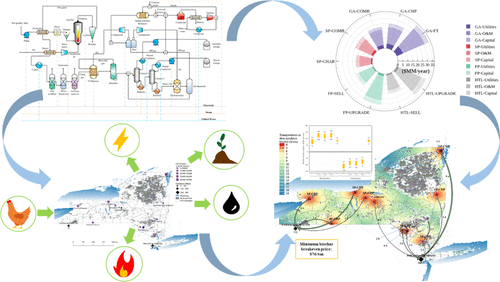当前位置:
X-MOL 学术
›
ACS Sustain. Chem. Eng.
›
论文详情
Our official English website, www.x-mol.net, welcomes your feedback! (Note: you will need to create a separate account there.)
Techno-Economic Feasibility and Spatial Analysis of Thermochemical Conversion Pathways for Resgional Poultry Waste Valorization
ACS Sustainable Chemistry & Engineering ( IF 8.4 ) Pub Date : 2020-04-03 , DOI: 10.1021/acssuschemeng.0c01229 Raaj R. Bora 1 , Yanqiu Tao 1 , Johannes Lehmann 2, 3 , Jefferson W. Tester 1, 3 , Ruth E. Richardson 3, 4 , Fengqi You 1, 3
ACS Sustainable Chemistry & Engineering ( IF 8.4 ) Pub Date : 2020-04-03 , DOI: 10.1021/acssuschemeng.0c01229 Raaj R. Bora 1 , Yanqiu Tao 1 , Johannes Lehmann 2, 3 , Jefferson W. Tester 1, 3 , Ruth E. Richardson 3, 4 , Fengqi You 1, 3
Affiliation

|
This study examines prominent thermochemical conversion technologies, such as slow pyrolysis, fast pyrolysis, gasification, and hydrothermal liquefaction, for treating poultry litter in New York State (NYS). Nine cases involving combinations of the four technologies and different downstream processing options such as bio-oil upgrading and Fischer–Tropsch conversion are chosen based on the product distribution. High-fidelity process simulations are performed to derive the mass and energy balance. Economic performance for the nine cases varied widely with largely overlapping net present values, ranging from $10MM to $170MM (slow pyrolysis), $89MM to $314.5MM (fast pyrolysis), $28MM to $196MM (hydrothermal liquefaction), and $25MM to $234MM (gasification). Both pyrolysis technologies had 18% to 56% lower greenhouse gas (GHG) emissions than the other technologies. GHG balances showed trade-offs with economic performance. Sensitivity analysis identified carbon credits, products’ market price, and plant capacity as the most influential factors. Building one centralized biorefinery in NYS especially for fast pyrolysis was more economically feasible than building multiple smaller biorefineries (biochar breakeven price of −$128 to −$91/ton vs $74 to $93/ton). The trend for slow pyrolysis was similar but with comparatively little difference (biochar breakeven price of $59 to $96/ton for one biorefinery vs $76 to $91/ton for multiple biorefineries).
中文翻译:

区域家禽废物热化的热化学转化途径的技术经济可行性和空间分析
这项研究研究了著名的热化学转化技术,例如慢速热解,快速热解,气化和水热液化,用于处理纽约州(NYS)的家禽垫料。根据产品分布,选择了9种案例,涉及四种技术的组合以及不同的下游加工方法,例如生物油提质和费托转化。执行高保真过程仿真以得出质量和能量平衡。九个案例的经济表现差异很大,净现值有很大的重叠,从$ 10MM到$ 170MM(慢速热解),$ 89MM到$ 314.5MM(快速热解),$ 28MM到$ 196MM(热液化)和$ 25MM。至$ 234MM(气化)。两种热解技术的温室气体排放量均比其他技术低18%至56%。温室气体余额显示了与经济表现之间的权衡。敏感性分析将碳信用,产品的市场价格和工厂产能作为最有影响力的因素。在纽约州建立一个集中的生物精炼厂,特别是用于快速热解,比在多个较小的生物精炼厂(生物炭收支平衡价格为-$ 128至-$ 91 /吨,$ 74至$ 93 /吨)更经济可行。缓慢热解的趋势相似,但差别不大(一个生物精炼厂的生物炭盈亏平衡价格为59-96美元/吨,而多个生物精炼厂的生物炭盈亏平衡价格为76-91美元/吨)。而工厂产能是最有影响力的因素。在纽约州建立一个集中的生物精炼厂,特别是用于快速热解,比在多个较小的生物精炼厂(生物炭收支平衡价格为-$ 128至-$ 91 /吨,$ 74至$ 93 /吨)更经济可行。缓慢热解的趋势相似,但差别不大(一个生物精炼厂的生物炭盈亏平衡价格为59-96美元/吨,而多个生物精炼厂的生物炭盈亏平衡价格为76-91美元/吨)。而工厂产能是最有影响力的因素。在纽约州建立一个集中的生物精炼厂,特别是用于快速热解,比在多个较小的生物精炼厂(生物炭收支平衡价格为-$ 128至-$ 91 /吨,$ 74至$ 93 /吨)更经济可行。缓慢热解的趋势相似,但差别不大(一个生物精炼厂的生物炭盈亏平衡价格为59-96美元/吨,而多个生物精炼厂的生物炭盈亏平衡价格为76-91美元/吨)。
更新日期:2020-04-03
中文翻译:

区域家禽废物热化的热化学转化途径的技术经济可行性和空间分析
这项研究研究了著名的热化学转化技术,例如慢速热解,快速热解,气化和水热液化,用于处理纽约州(NYS)的家禽垫料。根据产品分布,选择了9种案例,涉及四种技术的组合以及不同的下游加工方法,例如生物油提质和费托转化。执行高保真过程仿真以得出质量和能量平衡。九个案例的经济表现差异很大,净现值有很大的重叠,从$ 10MM到$ 170MM(慢速热解),$ 89MM到$ 314.5MM(快速热解),$ 28MM到$ 196MM(热液化)和$ 25MM。至$ 234MM(气化)。两种热解技术的温室气体排放量均比其他技术低18%至56%。温室气体余额显示了与经济表现之间的权衡。敏感性分析将碳信用,产品的市场价格和工厂产能作为最有影响力的因素。在纽约州建立一个集中的生物精炼厂,特别是用于快速热解,比在多个较小的生物精炼厂(生物炭收支平衡价格为-$ 128至-$ 91 /吨,$ 74至$ 93 /吨)更经济可行。缓慢热解的趋势相似,但差别不大(一个生物精炼厂的生物炭盈亏平衡价格为59-96美元/吨,而多个生物精炼厂的生物炭盈亏平衡价格为76-91美元/吨)。而工厂产能是最有影响力的因素。在纽约州建立一个集中的生物精炼厂,特别是用于快速热解,比在多个较小的生物精炼厂(生物炭收支平衡价格为-$ 128至-$ 91 /吨,$ 74至$ 93 /吨)更经济可行。缓慢热解的趋势相似,但差别不大(一个生物精炼厂的生物炭盈亏平衡价格为59-96美元/吨,而多个生物精炼厂的生物炭盈亏平衡价格为76-91美元/吨)。而工厂产能是最有影响力的因素。在纽约州建立一个集中的生物精炼厂,特别是用于快速热解,比在多个较小的生物精炼厂(生物炭收支平衡价格为-$ 128至-$ 91 /吨,$ 74至$ 93 /吨)更经济可行。缓慢热解的趋势相似,但差别不大(一个生物精炼厂的生物炭盈亏平衡价格为59-96美元/吨,而多个生物精炼厂的生物炭盈亏平衡价格为76-91美元/吨)。



























 京公网安备 11010802027423号
京公网安备 11010802027423号